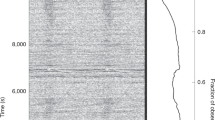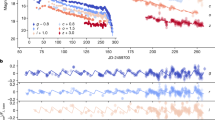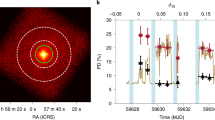Abstract
Geminga (2CG195+4) is one of the brightest sources in the sky at photon energies around 1 GeV (refs 1–3). It has been tentatively identified4 with an unusual soft X-ray and optical object for which the γ-ray-to-X-ray-to-optical luminosity ratios are ∼106:103:1, which may now have been confirmed by the discovery5 of a ∼60-s periodic variation in the X-ray source, similar to that reported in γ rays. The period has been increasing over the past 10 yr at a rate such that it doubles in ∼400–800 yr. The implied rotational energy loss would supply the γ-ray luminosity of Geminga if the spinning object were a neutron star at a distance of ∼10 pc, consistent with the very low observed X-ray absorption. A lone pulsar with a spin period of ∼60 s cannot spin down at the required rate. The observed period would need to be due to precession or some other process. We show here that the presence of a close neutron star companion provides a suitable mechanism. All neutron star binaries may evolve through a Geminga-like phase.
This is a preview of subscription content, access via your institution
Access options
Subscribe to this journal
Receive 51 print issues and online access
$199.00 per year
only $3.90 per issue
Buy this article
- Purchase on SpringerLink
- Instant access to full article PDF
Prices may be subject to local taxes which are calculated during checkout
Similar content being viewed by others
References
Fichtel, C. E. et al. Astrophys. J. 198, 163–182 (1975).
Thompson, D. J., Fichtel, C. E., Hartman, R. C., Kniffen, D. A. & Lamb, R. C. Astrophys. J. 213, 252–262 (1977).
Swanenburg, B. N. et al. Astrophys. J. Lett. 243, L69–L73 (1981).
Bignami, G. F., Careveo, P. A. & Lamb, R. C. Astrophys. J. Lett. 272, L9–L13 (1983).
Bignami, G. F., Caraveo, P. A. & Paul, J. A. Nature 310, 464–469 (1984).
Goldreich, P. & Lynden-Bell, D. Astrophys. J. 156, 59–78 (1969).
Michel, F. C. & Dessler, A. J. Astrophys. J. 251, 654–664 (1982).
Lamb, F. K., Aly, J.-J., Cook, M. C. & Lamb, D. Q. Astrophys. J. 274, L71–L75 (1983).
Parker, E. N. Cosmic Magnetic Field (Clarendon, Oxford, 1979).
Flowers, E. G. et al. Astrophys. J. 215, 291–301 (1977).
Itoh, N. Mon. Not. R. astr. Soc. 173, 1P–3P (1975).
Bignami, G. F. & Hermsen, W. A. Rev. Astr. Astrophys. 21, 67–108 (1983).
Arons, J. & Scharlemann, E. T. Astrophys. J. 231, 854–879 (1979).
Anderson, J. D. et al. Nature 308, 158–160 (1984).
Henrichs, H. F. & Van den Heuvel, E. P. J. Nature 303, 213–216 (1983).
Clark, J. P. A. in Sources of Gravitational Radiation (ed. Smarr, L.) 447–459 (Cambridge University Press, 1979).
Blandford, R. D., Applegate, J. H. & Hernquist, L. Astrophys. J. 204, 1025–1048 (1983).
Stephenson, F. R. Q. Jl. R. astr. Soc. 17, 121–138 (1976).
Ellison, D. C. & Kazanas, D. Astr. Astrophys. 128, 102–109 (1983).
Clark, J. P. A. & Eardley, D. M. Astrophys. J. 215, 311–322 (1977).
Author information
Authors and Affiliations
Rights and permissions
About this article
Cite this article
Nulsen, P., Fabian, A. Is Geminga a very close neutron star binary?. Nature 312, 48–50 (1984). https://doi.org/10.1038/312048a0
Received:
Accepted:
Issue date:
DOI: https://doi.org/10.1038/312048a0
This article is cited by
-
Detectability of γ-rays from clumps of dark matter
Nature (1990)
-
γ-ray sources: Does Geminga exist yet?
Nature (1985)
-
Chemical mechanisms of acid generation in the troposphere
Nature (1985)
-
Skyhook gravitational-wave detector
Nature (1985)



